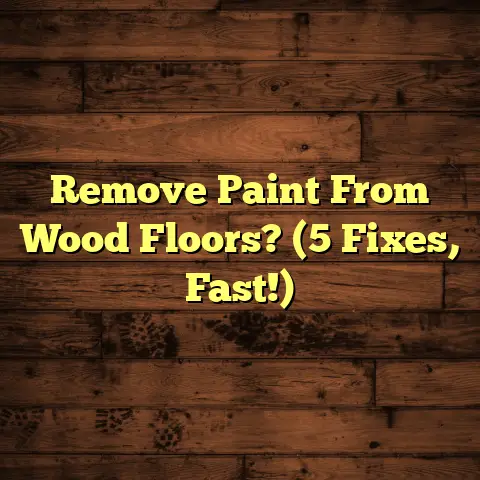Level Garage Floor: Crucial Steps! (4 To Avoid!)
A common misconception is that home improvement projects, especially flooring, are always wallet-draining endeavors. But guess what? Leveling a garage floor doesn’t have to break the bank!
Many homeowners overlook this simple upgrade, but trust me, it’s a game-changer. We’re talking about a safer, more functional space, and who doesn’t want that?
In this article, I’m going to walk you through the crucial steps to leveling your garage floor. I’ll also shine a light on four common mistakes that can turn your DIY dream into a costly nightmare. Ready to dive in?
Understanding the Importance of a Level Garage Floor
Why bother leveling your garage floor in the first place? Let me break it down for you:
-
Improved Safety: An uneven floor is a trip hazard waiting to happen. Leveling it out ensures stable footing, reducing the risk of slips and falls. Trust me, your ankles will thank you!
-
Enhanced Functionality: A level floor allows for proper drainage. No more water pooling and turning your garage into a swamp after a rainstorm. Plus, it makes cleaning a breeze.
-
Increased Property Value: Thinking of selling your home down the road? A level garage floor makes the space more appealing to potential buyers. It shows you care about the details, and that can make all the difference.
But it doesn’t stop there. An uneven garage floor can also wreak havoc on your vehicle maintenance and storage solutions.
Imagine trying to work on your car with a jack that’s constantly shifting because the floor isn’t level. Or picture your storage shelves wobbling precariously, threatening to topple over at any moment.
Leveling your garage floor enhances the overall utility of the space, making it a more practical and enjoyable area to work and store your belongings.
Tools and Materials Needed for Leveling
Alright, let’s talk tools and materials. Here’s what you’ll need to level your garage floor like a pro:
-
Concrete Mix or Self-Leveling Compound: This is the star of the show. Concrete mix is a classic choice, but self-leveling compound is easier to work with, especially for beginners.
-
Leveling Tools: You’ll need a long level (at least 6 feet), a straightedge, and a laser level. The laser level is optional, but it can make the job much easier and more accurate.
-
Mixing Tools: A mixer is ideal for larger projects, but a bucket and trowel will do the trick for smaller areas.
-
Safety Gear: Don’t forget gloves, goggles, and knee pads! Concrete can be harsh on your skin and eyes, and you’ll be spending a lot of time on your knees.
Now, let’s talk budget. You don’t have to spend a fortune to get high-quality materials. Here are some budget-friendly alternatives:
-
Concrete Mix: Instead of buying pre-mixed concrete, consider mixing your own using Portland cement, sand, and gravel. It’s cheaper, but it requires a bit more elbow grease.
-
Self-Leveling Compound: Look for smaller bags of self-leveling compound instead of large ones. You can always buy more if you need it, but you won’t be stuck with extra material if you don’t.
-
Leveling Tools: Rent a laser level from your local hardware store instead of buying one. It’ll save you a lot of money, and you’ll only need it for a day or two.
Where can you source these materials affordably? Check out your local hardware stores and online retailers like Amazon and Home Depot. Don’t be afraid to shop around and compare prices.
According to a recent survey by Angie’s List, homeowners who compare prices on materials save an average of 20% on their home improvement projects. That’s money in your pocket!
Step-by-Step Guide to Leveling Your Garage Floor
Okay, it’s time to get down to business. Here’s a step-by-step guide to leveling your garage floor:
1. Assessment of the Current Floor
Before you start mixing anything, you need to assess the current condition of your garage floor. Grab your long level and straightedge and start scanning the surface.
Identify any high and low spots. Use a pencil to mark these areas so you know where to focus your efforts.
You can also use a laser level to get a more accurate reading of the floor’s elevation. Set up the laser level in the center of the garage and shine the beam across the floor.
Use a measuring tape to measure the distance from the beam to the floor at various points. This will give you a clear picture of the floor’s contours.
2. Preparation
Now that you know what you’re dealing with, it’s time to prepare the garage. This means clearing out all your items and debris. Remove everything from the garage, including cars, tools, and storage containers.
Sweep the floor thoroughly to remove any loose dirt and debris. Use a shop vacuum to suck up any remaining dust and particles.
Next, you’ll need to clean the floor with a degreaser. This will remove any oil, grease, or other contaminants that could prevent the leveling compound from bonding properly.
Follow the manufacturer’s instructions for the degreaser. Typically, you’ll need to apply the degreaser to the floor, let it sit for a few minutes, and then scrub it with a brush. Rinse the floor thoroughly with water and let it dry completely.
3. Mixing the Compound
Now comes the fun part: mixing the leveling compound. Follow the manufacturer’s instructions carefully. The consistency of the mixture is crucial for a successful leveling job.
If you’re using concrete mix, you’ll need to mix it with water according to the instructions on the bag. Use a mixer or a bucket and trowel to combine the ingredients.
Add water gradually until you achieve a thick, but pourable consistency. The mixture should be similar to pancake batter.
If you’re using self-leveling compound, you’ll need to mix it with water as well. Again, follow the manufacturer’s instructions carefully.
Self-leveling compound typically requires less water than concrete mix. The mixture should be thin and watery, but not too runny.
4. Application
Once your leveling compound is mixed, it’s time to apply it to the floor. Start by pouring the mixture into the low spots you identified earlier.
Use a trowel or squeegee to spread the mixture evenly across the floor. Work in sections, starting with the deepest low spots and gradually filling in the shallower ones.
If you’re using self-leveling compound, it will spread out on its own. Simply pour the mixture onto the floor and let it flow into the low spots.
Use a gauge rake to help spread the compound evenly. The gauge rake will ensure that the compound is applied at the correct thickness.
5. Curing and Finishing
After you’ve applied the leveling compound, you’ll need to let it cure. The curing process can take anywhere from 24 to 72 hours, depending on the type of compound you used.
Check the manufacturer’s instructions for specific curing times. During the curing process, keep the garage door closed and avoid walking on the floor.
Once the compound has cured, check for levelness using your long level and straightedge. If you find any uneven spots, you can apply another thin layer of leveling compound to correct them.
6. Final Touches
Once the floor is level and fully cured, you can add some final touches to enhance its durability and appearance.
Consider sealing the floor with a concrete sealer. This will protect the floor from stains, spills, and other damage.
You can also paint the floor with a concrete paint. This will add color and style to your garage. Choose a paint that is specifically designed for concrete floors.
Four Common Mistakes to Avoid When Leveling Your Garage Floor
Now, let’s talk about the pitfalls. Here are four common mistakes homeowners make when leveling their garage floor:
1. Skipping the Assessment Step
I cannot stress this enough: do not skip the assessment step!
Failing to thoroughly assess the floor before leveling is like trying to bake a cake without a recipe. You’re just guessing, and the results are likely to be disastrous.
Without a proper assessment, you won’t know the extent of the unevenness, and you’ll end up applying too much or too little leveling compound. This can lead to an uneven floor, wasted materials, and a lot of frustration.
I once worked with a homeowner who skipped the assessment step and ended up with a garage floor that was even more uneven than before. He had to tear it all out and start over, costing him time, money, and a whole lot of stress.
2. Using the Wrong Materials
Choosing the wrong leveling compound can also lead to problems. Low-quality or unsuitable compounds may not bond properly to the existing concrete, resulting in cracking, peeling, and an uneven surface.
I’ve seen homeowners try to use drywall compound or even wood filler to level their garage floors. These materials are not designed for concrete and will not hold up under the weight of vehicles and other heavy items.
Always use a leveling compound that is specifically designed for concrete floors. Read the product label carefully to make sure it’s suitable for your project.
3. Neglecting Proper Preparation
Proper preparation is key to a successful leveling job. If you don’t clean and prepare the surface properly, the leveling compound may not adhere correctly, leading to cracks, bubbles, and an uneven finish.
I’ve seen homeowners skip the degreasing step and apply leveling compound directly over oil and grease stains. The compound simply didn’t stick, and the floor ended up looking worse than before.
Take the time to clean the floor thoroughly with a degreaser and rinse it with water. This will ensure that the leveling compound bonds properly to the concrete.
4. Rushing the Curing Process
Patience, my friends, is a virtue, especially when it comes to curing concrete. Rushing the curing process can lead to cracking, shrinking, and an uneven surface.
I’ve seen homeowners walk on their freshly leveled garage floors just a few hours after applying the compound. The result was a series of footprints and an uneven surface that had to be repaired.
Allow the leveling compound to cure for the recommended amount of time. Keep the garage door closed and avoid walking on the floor during the curing process.
Conclusion
So, there you have it: a comprehensive guide to leveling your garage floor like a pro. Remember, a level garage floor is not just about aesthetics; it’s about safety, functionality, and increasing your property value.
And the best part? It’s an affordable project that you can tackle yourself with the right tools, materials, and knowledge.
Don’t be afraid to take pride in your home improvement efforts. A level garage floor can add value to both your daily life and your property.
By avoiding the common pitfalls I’ve outlined, you can ensure a smooth and successful leveling experience. So go ahead, grab your tools, and get ready to transform your garage into a level, functional, and beautiful space!
Remember, the satisfaction of completing a DIY project is priceless. And with a little effort and attention to detail, you can achieve a professional-looking result that you’ll be proud of for years to come. Good luck!





